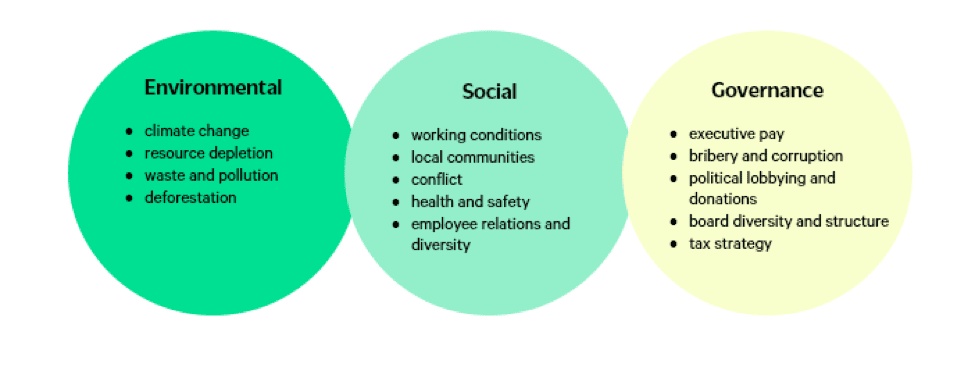The GRI is a global standard for sustainability reporting designed by organizations and investors to measure business performance. The GRI has been adopted as a requirement by leading institutional investors, government regulators, and development organizations around the world. It sets out a universal framework for sustainability reporting based on the shared understanding that such information can provide new insights into how companies operate and their contribution to sustainable development.
The Global Reporting Initiative (GRI) was established in 1997 when it became clear that there was an increasing need for an internationally accepted set of standards that would allow stakeholders – governments, NGOs, investors, consumers, etc.,- to compare consistent information relating to environmental issues from one company or country with another in order to assess progress towards sustainability goals and objectives. Since its inception, the GRI has developed more than 200 Sustainability Reporting Guidelines, which are available free of charge.
- What does the GRI do?
- Why was the GRI created?
- What are the GRI standards?
- 6 most important benefits of reporting
- What are the Sustainability Reporting Guidelines?
- How does the GRI Standards work?
- What are GRI reports?
- What is the function of the Global Reporting Initiative?
- What are the three stages of GRI?
- What are the GRI series standards?
- How are the GRI standards used?
- What is the purpose of GRI reports?
- Who uses the Global Reporting Initiative?
- Why is the Global Reporting Initiative important?
- What is the difference between sustainability and CSR?
- What is the purpose of sustainability reporting?
- What are the three ways you can read a report?
- Is sustainability reporting mandatory?
- How can GRI sustainability reporting help organizations?
- In conclusion regarding the global reporting initiative GRI
- Terms and Definitions
- Caveats, disclaimers, and define GRI
What does the GRI do?
The GRI works with its stakeholders to create awareness about how reporting can support sustainable development. It also provides practical guidance and reporting tools to help organizations measure and report on their economic, environmental, and social performance. These include sectorial supplement guidelines as well as sectorial and thematic thematic supplements which provide guidance on specific topics such as human rights, conflict minerals, and farm labor. New guidelines are developed every year in the areas of people, planet, and governance.
Why was the GRI created?
To create GRI, an international committee of representatives from UN organizations, investor agencies, corporations, practitioners and civil society groups came together to develop a set of rules or “principles” for sustainability reporting. The process was designed using the following guiding principles: inclusion; transparency; comparability; alignment; credibility; relevance; and insightfulness. These principles are expected to ensure that sustainability reports show not just what is happening but how well businesses are performing in relation to sustainable development goals.
What are the GRI standards?
The Global Reporting Initiative has three interwoven Standards that apply universally to every entity, company, or organization who are creating reports (15 Reasons Why You Should Make One) on their sustainability practices.
6 most important benefits of reporting
- Transparent and Open: A company can share its assessment with others without disclosing commercially sensitive information.
- Standardized Approach: The GRI Indicators, Guidelines, and reporting requirements provide a framework within which public and private organizations can report on their sustainability performance.
- Co-created: The GRI is a co-developed initiative, not owned by any organization. It represents the consensus of investors and other stakeholders about what information matters most for understanding an organization’s impact on society and the environment; who should report this information; and how it should be reported.
- Gap Analysis: The GRI provides a basis for organizations to assess their own performance and risks relative to other companies, and to identify opportunities for improvement.
- Engagement: An organization can engage with its stakeholders using the same information and reporting framework as it uses to communicate its sustainability performance internally and externally, avoiding the need for multiple frameworks and reports.
- Donor Appeals: A charity can demonstrate its commitment to sustainability through the use of the GRI as a means of disclosing information about an organization’s performance on social, environmental, and economic impacts. This provides reassurance that their donations are being used effectively and efficiently toward these ends.
What are the Sustainability Reporting Guidelines?
The GRI Standards are divided into three components:
- the Sustainability Reporting Guidelines, which provide guidance for how organizations are to report on economic, environmental and social performance;
- the Supplement guidelines which provide guidance to supplement the reporting process in specific areas such as human rights or climate change;
- and the GRI Guidelines for Report Users, which provide information on how to read and interpret the contents of a corporate sustainability report.
The Sustainability Reporting Guidelines are the development of more than 200 guidelines that set out requirements for reporting on economic, environmental, and social performance from an organization’s perspective. The GRI ensures these standards remain up-to-date by reviewing them at least every four years. The Sustainability Reporting Guidelines are Approved by GRI’s General Assembly on what to put in your sustainability report.
Organizations adopting the Standards are encouraged to follow the framework of the GRI when reporting, but it is their responsibility to determine what information or data is appropriate for inclusion in the report. The use of specific indicators within the framework is not a requirement.
You can’t improve what you don’t measure.
Free Verified Carbon Calculators.
Erase Your Carbon Footprint in less than 5 Minutes
Personal Carbon Footprint Calculator
Business Carbon Footprint Calculator
How does the GRI Standards work?
The Sustainability Reporting Guidelines are made up of seven categories: people, planet, and governance; strategy and performance management; portfolio management and operations; stakeholder engagement; risk, opportunity & impacts; carbon & energy; and financials [notes]. These categories are further divided into guidelines which are organized according to economic, environmental, and social performance.
The GRI Standards focus on material aspects of sustainability or those that have a significant impact on the organization’s activities.
As organizations continue their journey towards sustainable development, they use the GRI Standards as an opportunity to improve their reporting practices in order to provide more in-depth information about their contribution to sustainable development.
What are GRI reports?
The Sustainability Reporting Guidelines, which is made up of three components: the guidelines themselves, the Supplement guidelines, and the Guidelines for Report Users. The Standards are intended to be used by organizations in building transparency through reporting on their economic, environmental, and social effects.
In order to achieve this, GRI is committed to working with its stakeholders in delivering a multi-stakeholder platform for the development of universal Guidelines through a transparent process that provides opportunities for input from all interested parties in a timely manner, thus creating a foundation for improved decision-making.
Reporting organizations are responsible for determining what information or data is appropriate for inclusion in their reports.
What is the function of the Global Reporting Initiative?
The GRI serves two distinct roles:
1) As an independent standard-setter for sustainability reporting; and
2) As a platform for global collaboration between companies, civil society, and investors.
The first role is defined by the standard-setting task, which involves a number of boards and an Advisory Council made up of representatives from civil society organizations, investors, companies, and others.
The second role is activated through dialogue activities that place a strong emphasis on sharing knowledge to accelerate progress toward sustainability goals. In this way, the GRI has become a platform for global collaboration between companies, civil society organizations, and investors.
What are the three stages of GRI?
1. Issue Identification: A company identifies issues that are relevant to its business and which affect stakeholders, setting out what will be included in the report.
2. Assessment/Analysis: An assessment is carried out (either by the organization itself or by an independent assessor) in order to establish how the issues identified affect the organization and its impacts on those affected by it.
3. Reporting: The company provides information to stakeholders about how this analysis has been carried out, as well as the results of the assessment and any other relevant issues that have come to light throughout this process.

What are the GRI series standards?
- The 200 series is comprised of Economic topics
- The 300 series is comprised of Environmental topics
- The 400 series is comprised of Social topics
How are the GRI standards used?
The standards set out requirements that organizations can apply to their own unique context to report on economic, environmental, and social performance. The standards are designed for use globally by any organization regardless of size or sector.
The GRI Standards are used by companies large and small. They are also adopted as requirements in many countries around the world, most notably the United States, France, Brazil, Canada (Canadian Index of Wellbeing), China, Denmark, Finland, Germany and Korea. This “requirement” is referred to as a mandatory requirement because these governments have either passed legislation or issued regulations requiring publicly listed companies to report on economic, environmental, and social impacts.
What is the purpose of GRI reports?
The primary purposes of a GRI Report are:
- To allow for comparisons over time;
- To provide stakeholders with insights into an organization’s performance as it relates to sustainability; and
- To enhance transparency and accountability.
The GRI enables comparisons over time by providing a common framework for organizations to report on their long-term performance in a way that is independent, credible, and transparent. The quality of data contained within a GRI Report makes it possible for stakeholders to gain insight into an organization’s current performance relative to its targets and previous performance. This insight, coupled with the credibility of a GRI Reports’ independent certification, can enhance accountability and transparency by enabling stakeholders to engage organizations proactively on issues of key importance to them.
Who uses the Global Reporting Initiative?
The Global Reporting Initiative is a universal standard for sustainability reporting designed by organizations and investors to measure business performance. The GRI has been adopted as a requirement by leading institutional investors, government regulators, and development organizations around the world. The GRI sets out a universal framework for sustainability reporting based on the shared understanding that such information can provide new insights into how companies operate and their contribution to sustainable development.
Why is the Global Reporting Initiative important?
The GRI is important because it can provide investors with information that is credible, transparent, and independent. It sets out universal standards for sustainability reporting based on the belief that such information can provide new insights into how companies operate and their contribution to sustainable development.
What is the difference between sustainability and CSR?
Sustainability is the ability to be sustained. This means that sustainable actions take into account all aspects of society and will not harm future generations. It is about maintaining the natural resources in order to allow for future generations to thrive. CSR, or corporate social responsibility, is different in that it does not always take into account future generations. It only focuses on the existing stakeholders in the company and what they need/want at this point in time.
Go Carbon Neutral – in only 3 Minutes!
What is the purpose of sustainability reporting?
Sustainability reporting is a way for a company to measure its success in sustainability and provide information about what is being done. CSR focuses more on benefiting the existing group, whereas sustainability is all about maintaining resources for future generations by including them from the start. The two practices also have contrasting goals: one is often focused on marketing, while the other’s goal can be better management of natural resources.
What are the three ways you can read a report?
1. Company provides self-assessment: In this case, a company assesses its own performance in the G4 categories and completes a report on each of the nine GRI Indicators that it considers relevant.
2. Company or Investor makes a request: In this case, a request is made for a report from an organization, either by an investor asking about their holdings, or by an interested party about an organization they are evaluating.
3. The company is requested to provide a basic report: this is agreed by the board of directors or senior management but does not constitute a self-assessment. Instead, it contains only information that the company has chosen to include. This can be useful if there are concerns about whether a GRI indicator is relevant or not.
Is sustainability reporting mandatory?
Sustainability reporting is not mandatory, but takes a company’s performance and makes it transparent. In turn, this can help companies be better equipped to make profitable decisions to improve their long-term success. To draw out the most value from sustainability reporting, it is important for organizations of all sizes and sectors to produce useful information in a format that stakeholders understand.
How can GRI sustainability reporting help organizations?
Sustainability reports provide a clear picture of how an organization operates so investors can track progress. They also offer a way for stakeholders to engage with organizations proactively to ensure accountability and transparency.
More interesting things…
How to Write a Sustainability Report
In conclusion regarding the global reporting initiative GRI
In conclusion, the Global Reporting Initiative (GRI) is a global standard for sustainability reporting designed by organizations and investors to measure business performance. The GRI has been adopted as a requirement by leading institutional investors, government regulators, and development organizations around the world. Sustainability reporting helps companies be more efficient and profitable through better management of natural resources. It also enables them to better engage with stakeholders and hold themselves accountable for their actions.
Terms and Definitions
- A comprehensive sustainability reporting framework is a set of principles and guidelines for systematically reporting an organization’s economic, social, and environmental performance.
- The Global Reporting Initiative (GRI) is a reporting framework that provides guidance to organizations on how to report their sustainability performance.
- Intergovernmental expectations are the expectations of national and international organizations regarding an organization’s sustainability performance.
- A reporting framework is a set of guidelines for systematically reporting an organization’s economic, social, and environmental performance.
- Corporate social responsibility refers to the responsibilities that a company has to society as a whole. This includes things like environmentalism, philanthropy, and human rights.
- Sustainability performance is the way in which a company manages its environmental and social impact.
- Global standards are the set of guidelines that companies use to measure their sustainability performance.
- Stakeholder groups are the people and organizations who have a vested interest in a company’s success or failure.
- Gri guidelines are the set of global standards that companies use to measure their sustainability performance.
- Governance bodies are the organizations responsible for setting and enforcing global standards.
- Social sustainability – The ability of a social system to endure over time by managing and regenerating its social, environmental, and economic resources.
- Modular Structure – A modular structure is one that is divided into smaller, interchangeable parts.
- Reporting – The act of providing information or making something known.
- Core Option – The most important or essential part of something.
- Environment Ideation – The process of coming up with new ideas about how the environment can be improved.
Caveats, disclaimers, and define GRI
We have covered many topics in this article and want to be clear that any reference to, or mention of revised universal standards, reporting companies, United Nations environment program, international organizations, multinational enterprises, GRI designation, human rights, universal standards, other organizations, national association, reporting standards, supply chain, promotes economic or helps businesses with standards for sustainability reporting. We have also talked about GRI ESG responsible investing, GRI meaning, and GRI sustainability reporting standards. Other subjects have included, but are not limited in accordance with the GRI outlines to enable principles and services for businesses, widely, governance, country, resources, transparency, biodiversity, business, accordance, association, revised, world, emissions, network, reports, management, standards, practices, identified, advancing, advice, realtors or health in the context of this article and are purely for informational purposes and not to be misconstrued with investment advice or personal opinion. Thank you for reading, We hope that you found this article useful in your quest to understand ESG.

Dean Emerick is a curator on sustainability issues with ESG The Report, an online resource for SMEs and Investment professionals focusing on ESG principles. Their primary goal is to help middle-market companies automate Impact Reporting with ESG Software. Leveraging the power of AI, machine learning, and AWS to transition to a sustainable business model. Serving clients in the United States, Canada, UK, Europe, and the global community. If you want to get started, don’t forget to Get the Checklist! ✅
